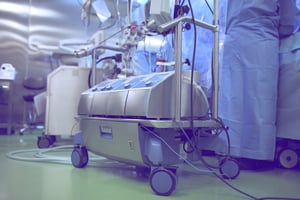
For some with severe lung diseases, a lung transplant surgery may be done to help improve breathing ability.
Lung transplant surgeries are often done on those with severe lung disease who have tried other medications and treatments and had no success.
A lung transplant can consist of replacing one lung, both lungs, or both lungs and the heart.
Though a lung transplant can be dangerous, the results can improve quality of life dramatically.
Why a Lung Transplant Surgery is Done
Lung transplant surgery is often done for those who have very severe lung diseases, resulting in low lung function.
Some diseases that may result in a lung transplant surgery include COPD, pulmonary fibrosis, cystic fibrosis and pulmonary hypertension.
Most lung diseases are first treated with medications and treatments in order to reduce pain and hopefully slow the progression of the disease.
Lung transplant is often the last resort after lung function is too low, to the point of life-threatening.
Depending on how damaged one, or both lungs are, a single-lung transplant or a double-lung transplant may be recommended.
For those with coronary artery disease, a procedure to correct blood flow may be done in additional to the lung transplant.
If someone has both heart and lung diseases, a heart and lung transplant may be done at the same time.
Risk Factors of a Lung Transplant
The first risk associated with a lung transplant is the risk of rejection.
The immune system is there to protect the body from foreign invaders, which can put the individual at risk of rejection.
Medical professionals will do their best to match the patient and the donor, but even a good match can have complications.
Anti-rejection drugs may be prescribed for the remainder of the patient’s life to prevent rejection for the rest of their life.
These medications weaken the immune system, so it does not attack the lungs, but it can also mean the patient is more likely to get an infection.
Another risk factor of a lung transplant in infection.
The anti-rejection drugs weaken the immune system in order for it not to attack the donor lung, but it can also mean it cannot protect the body against other foreign invaders.
Before surgery the doctor will most likely go over what will need to be done after surgery to avoid infections.
After surgery, it is important to wash hands regularly, brush teeth and gums regularly, protect skin from scratches or sores, avoid large crowds and those who may be ill and getting all appropriate vaccinations.
These steps can help prevent any growth of bacteria and minimize any risk of infection.
What to Expect Before Surgery
When it is deemed that a new lung is needed, the patient is often referred to a transplant center to get evaluated.
While at the transplant center, they will perform tests and look at medical history of the patient to determine if they are a good candidate for a transplant.
If it is deemed that a lung transplant is needed, the patient will be put on a waiting list, which can range from weeks to years.
Throughout this time, the medical team at the transplant center will keep and eye on their condition to adjust treatment, if needed, while they wait for a transplant.
As an organ becomes available, there is then a matching system that matches the donor organ with a recipient.
Some criteria that is used is blood type, size of organ, geographic location of both the donor and recipient, recipient’s overall health and lung disease severity and the likelihood of a successful transplant.
The system used to find the match between donor and recipient is called United Network for Organ Sharing (UNOS).
The patient will then be notified that a donor is available, and the recipient will be given instructions on what to do next.
What to Expect During Surgery
As a lung transplant is a very serious surgery, the patient will be put under general anesthesia to make sure the surgery goes smoothly.
There will be a tube inserted into the mouth to help breathe while the patient is under.
A large cut will be made in the chest to open the chest and remove the damaged lung.
Depending on the transplant, the patient may be connected to a heart and lung bypass machine to help circulate blood throughout the body while undergoing surgery.
The machine is not used in every transplant but is kept nearby in case it is needed.
After the donor organ is put into position, the surgeon will connect the arteries, veins and airways to the rest of the body.
A drainage tube will be inserted to keep fluid and air buildup at a minimum.
On average the surgery can last up to eight hours, depending on if it is a single-lung, double-lung or a heart and lung surgery.
What to Expect After Surgery
After surgery the patient will go into recovery in the intensive care unit (ICU) for a handful of days following surgery.
A mechanical ventilator can help with breathing for a few days following surgery, and drainage tubes will remain in the chest cavity as well.
The patient will be on medication to help control pain and to avoid rejection of the lung.
Depending on the surgery and how the patient is recovering, a stay at the hospital can last anywhere from a week to an entire month.
Once released from the hospital, the patient will be monitored closely for the following three months to make sure lung function is returning and the lung is not being rejected.
The medical team will keep an eye on the overall health of the patient and look for signs of rejection, such as shortness of breath, fever, coughing or chest congestion.
They often make adjustments to medications and treatment plans long after surgery to maintain healthy lungs.
Conclusion
For many with severe lung diseases, a lung transplant is most likely an option for treatment.
There are risks associated with a lung transplant surgery, but if it means an easier time breathing, it may be worth it.
The medical team will assess if the surgery is right for the patient, and from there is it a waiting game on when a lung becomes available.



